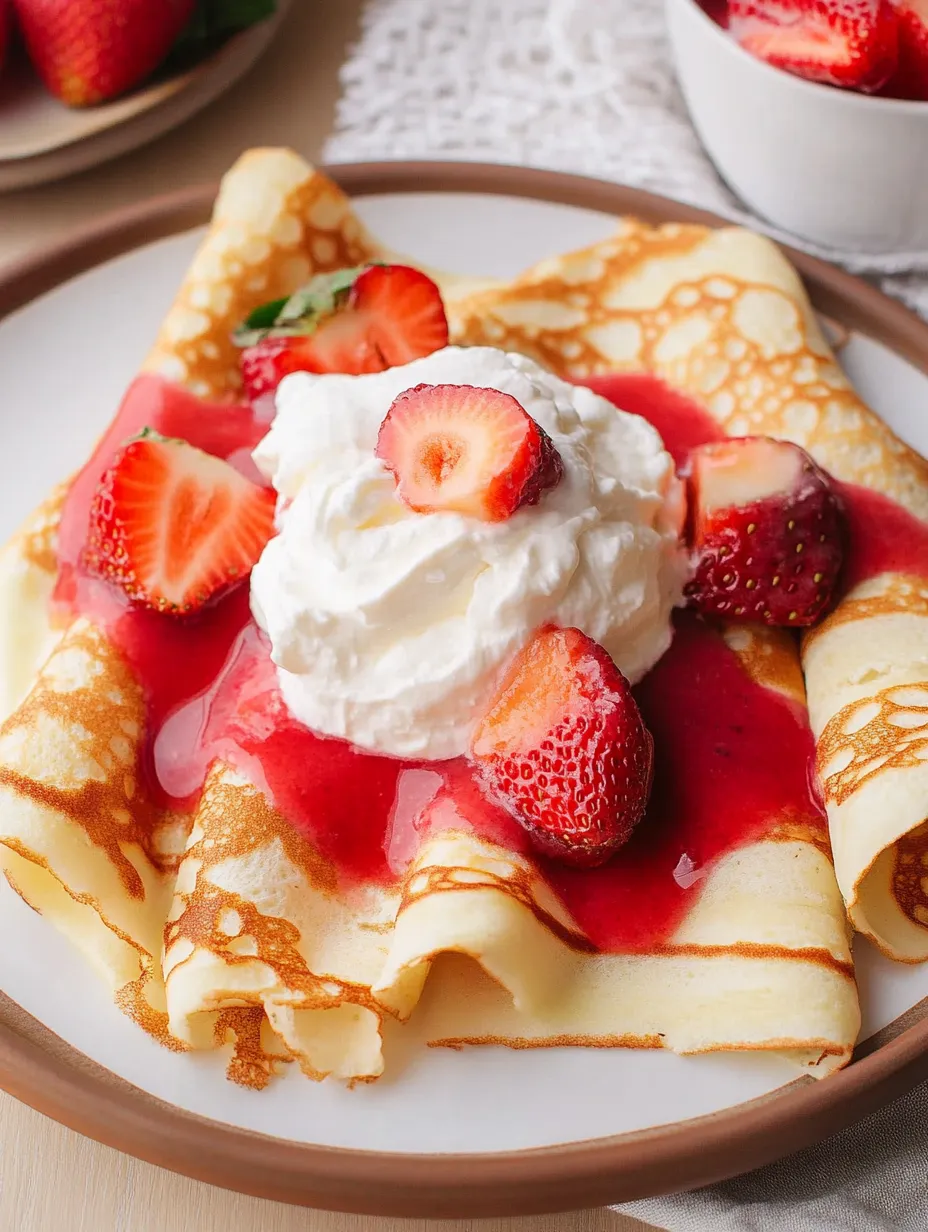 Pin it
Pin it
These strawberry crepes became a Sunday morning tradition in our house after a trip to Paris years ago, where my husband and I fell in love with the street vendors' simple but perfect crepes. I spent months tweaking the recipe to get that perfect balance of tender, lacy edges and a slightly sweet batter that complements rather than competes with the filling. The combination of fresh whipped cream, juicy strawberries, and that vibrant strawberry sauce creates this perfect harmony that feels special enough for company but simple enough for a weekend breakfast treat.
My mother-in-law, who's notoriously picky about breakfast foods, actually requested these for Mother's Day brunch last year! My teenage daughter has started making them for her friends during sleepovers, and her friends' parents now ask me for the recipe. There's something about that combination of tender crepes and fresh strawberries that just feels like sunshine on a plate.
Fresh Ingredients
- Sparkling water: This is my secret ingredient that makes the crepes extra light and delicate with those beautiful lacy edges. Regular water works too, but the bubbles create the most wonderful texture.
- Fresh strawberries: During peak strawberry season, these crepes are absolutely transcendent. In winter, I've used frozen berries for the sauce (thawed first), but fresh berries for the filling make all the difference.
- Heavy cream: For that perfect cloud-like whipped cream that holds its shape without being too stiff. The slight tang of the cream balances the sweetness of the berries beautifully.
- Vanilla extract: Just a touch in all three components (batter, whipped cream, and sauce) creates this wonderful aromatic background note that ties everything together.
- Lemon zest: This brightens the strawberry sauce in a way that's subtle but makes all the difference. Without it, the sauce can taste a bit flat and one-dimensional.
 Pin it
Pin it
Step-by-Step Instructions
- Silky batter making
- Creating that perfectly smooth batter starts with the right mixing technique. I blend all the ingredients together at once, which prevents overworking the flour (a common mistake that leads to tough crepes). Using an immersion blender makes this effortless, but a regular blender or even vigorous whisking works too. My first attempts at crepes were too thick because I was afraid of making the batter too thin - now I know that it should be the consistency of heavy cream.
- Perfect resting period
- Achieving that ideal texture requires a bit of patience. Letting the batter rest for at least 20 minutes (while you prep the other components) allows the flour to fully hydrate and the gluten to relax. This creates more tender crepes and helps prevent tearing when you flip them. I've skipped this step when in a hurry, and while they still taste good, the texture isn't quite as perfect.
- Pan preparation
- Getting that ideal cooking surface takes the right approach. I use a well-seasoned 8-inch nonstick skillet dedicated just to crepes. The first crepe is almost always a practice one (the French call it the "sacrifice" crepe), so don't get discouraged if it's not perfect. I brush a tiny bit of butter on the pan before each crepe using a silicone pastry brush - too much butter and they get greasy, too little and they stick.
- Pouring and swirling technique
- Creating those perfectly thin crepes takes a bit of practice. The key is to lift the pan off the heat, quickly pour in just enough batter (about 3 tablespoons), and immediately tilt and swirl to coat the bottom of the pan before the batter sets. I use my right hand to pour and my left to swirl, working quickly. My first few attempts were too thick in some spots and had holes in others, but after a few tries, it becomes almost meditative.
- Flipping finesse
- Mastering the flip without tearing requires patience. Wait until the edges look dry and slightly lacy, and the surface no longer looks wet - usually 30-60 seconds depending on your heat level. I gently loosen the edges with a thin spatula, then slide it underneath to check that the bottom is golden before flipping. The second side needs much less time, just enough to set the batter.
- Stacking strategy
- Keeping crepes warm without getting soggy takes the right approach. I stack them on a plate as I cook, which keeps them warm and prevents them from drying out. If I'm making them far in advance, I'll place parchment paper between each one, then wrap the stack in foil and keep warm in a very low oven (about 200°F). But honestly, they're best made just before serving.
My first attempt at crepes years ago was a bit of a disaster - I used a regular frying pan that was too large, made the batter too thick, and tore almost every crepe trying to flip them. I've gradually refined my technique, learning that the right pan size, proper batter consistency, and patience while cooking make all the difference. I've also played with the filling over time - tried mascarpone instead of whipped cream once (delicious but heavy), and experimented with different berry combinations (mixed berries make a beautiful purple sauce!).
Serving Style
These beautiful crepes deserve special treatment when serving! For casual family breakfasts, I often fold them into quarters and arrange them slightly overlapping on plates, with the sauce drizzled over top. For more elegant brunches, I roll them into cylinders and place two per plate with a small pitcher of extra sauce on the side and fresh mint for garnish. They pair beautifully with champagne for a celebration or with coffee for a more casual gathering. For an extra-special dessert version, I sometimes add a scoop of vanilla ice cream instead of whipped cream inside each crepe.
Flavor Variations
These versatile crepes welcome creative adaptations while keeping that wonderful delicate texture. During peach season, I substitute fresh sliced peaches and a peach sauce made the same way as the strawberry version. In fall, cinnamon-spiced apples with a caramel drizzle make a wonderful variation. For chocolate lovers, adding a thin spread of Nutella under the whipped cream creates an indulgent twist. And for a more sophisticated adults-only version, try adding a splash of Grand Marnier to both the whipped cream and the sauce.
Make-Ahead Tips
These crepes work beautifully as a prepare-ahead meal with a little planning. The batter actually improves if made the night before and refrigerated - the flour hydrates more fully and the crepes cook even better. The strawberry sauce can be made up to 3 days ahead and kept refrigerated. The only component I always make fresh is the whipped cream, which takes just minutes. Cooked crepes can be refrigerated for up to 2 days - layer them between parchment paper in an airtight container, then warm briefly in a skillet or microwave before filling.
 Pin it
Pin it
I discovered my love for crepes during that magical trip to Paris, but perfecting them at home has been a journey of small tweaks and improvements. There's something deeply satisfying about mastering this seemingly fancy but actually quite simple technique. While they might look impressive, they're actually one of the more forgiving breakfast recipes in my collection. The way people's eyes light up when they see that stack of delicate crepes with bright strawberry sauce makes the effort worthwhile every single time.
Frequently Asked Questions
- → Can I make crepe batter ahead of time?
- Yes! The batter actually benefits from resting. You can make it up to 24 hours ahead and store it covered in the refrigerator. Just give it a quick whisk before using.
- → What's the best pan for making crepes?
- A specialized crepe pan works best, but any non-stick skillet with low sides will work well. An 8-10 inch pan is the ideal size for manageable crepes.
- → Why use sparkling water in crepe batter?
- The carbonation in sparkling water creates tiny bubbles in the batter, resulting in lighter, more delicate crepes. You can substitute still water or additional milk if needed.
- → Can I freeze crepes?
- Yes! Cook the crepes and let them cool completely. Stack them with pieces of parchment paper between each crepe, wrap well, and freeze for up to 1 month. Thaw in the refrigerator before filling.
- → What other fillings work well with crepes?
- Crepes are versatile! Try Nutella and bananas, lemon curd and blueberries, or go savory with ham and cheese, spinach and mushrooms, or eggs and herbs.
